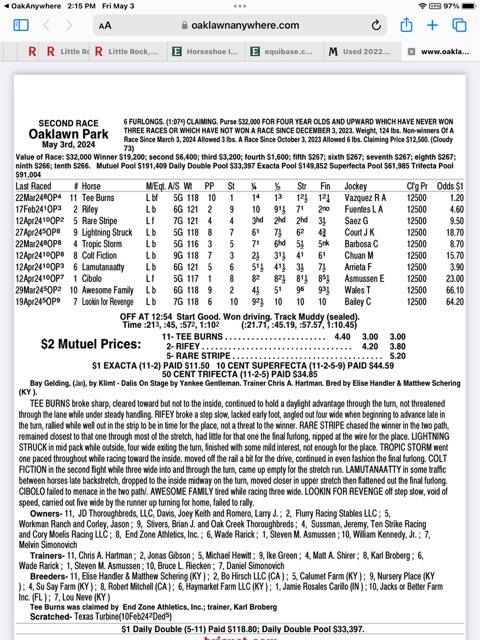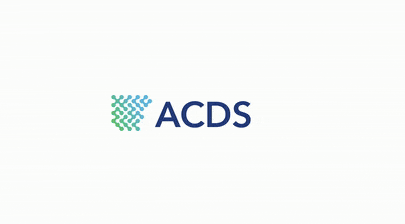AT AN ECLIPSE party in Little Rock in early April, one of the guests was glued to her laptop, which was showing a horse race at the Horseshoe Indianapolis track, and she was jotting down numbers as the ponies ran. Turns out that Abbey Shoemaker literally grew up in the shadow of Oaklawn Park, and she’s worked in racing for decades. Today she’s a Chartcaller and/or Call Taker for Equibase, one of the biggest names in racing data. Always looking for a good tech story, we asked Abbey to explain how she collects her data and how it’s used—and what excited her about the racing world in the first place.
———————————
Before we get to the business of Chartcalling and Call Taking, tell us about falling in love with the racetrack.
My mother and stepfather lived behind Oaklawn, so that was always where I wanted to go. You had to be 16 to get into the track in those days, so my friends and I would stand along that back fence and watch the horses run. And if I got lucky, my stepfather would have some business on the back side and I’d get in the car and ride around there with him and look at horses. It was very exciting.
When I was in college, I got a job at the racetrack. My classes were on Tuesdays and Thursdays, so I had the other days free. Usually, it worked out. And then I’d beg my professors to let me take my final exam before the Kentucky Derby so I could run off to Kentucky. Then I just wound up not coming back all the time. I haven’t been now in a few years, but for a long time I was there working every year. Depending on what I was doing, it’s a long day, I’d be up at 4 a.m. on Derby Day doing something before I went to another job, and then to another job. At one point, I had five jobs at once.
What do you think is the attraction?
It’s like running off to the circus. And I just love the horses. But I did graduate from college, just not on time like I should have. I got a degree in Journalism and kept thinking, How am I going to use this? I took some of the strangest jobs on the track, and eventually I managed to get an interview with somebody at the Daily Racing Form—and I still had to wait for a job, because at the Racing Form, nobody quit and nobody retired. Someone had to die before a job opened up. Because everybody who worked there just loved it.
Most of us travel around like gypsies, and they’ll arrange for lodging. I had a pickup truck back then, and I’ve got a two-seater now. But you learn to pack and move quickly. My boss called and said, “Can you be in Oklahoma in three days?” “I can be there in three hours,” I said.
I love the horses, as I said, but I love the people too. Most of the people I know in the racing world are very, very good people, and they all kind of come together if something happens.
Okay, so tell me about Equibase and what you do for them.
The racetracks time the races and I don’t know how long they’ve been doing that—ever since stopwatches were invented, I guess. The Racing Form started in 1894. Equibase is an industry-owned company, and our charts are the very same that are in the Racing Form.
Okay, Chartcalling and Call Taking—please explain.
The Chartcaller calls out the positions of the horses during a race, and the Call Taker enters those positions. At some tracks I call the races and at other tracks I’ve had to do both jobs by myself.
In Indiana I work with a Chartcaller named Craig Jones, an old friend. We’re usually working together, in person, but I’ve been given the chance to work remotely at home in Little Rock, and I want to take advantage of that. A little bit more coordination is needed when I’m not actually there at the race, but Craig and I make it work. If he weren’t a friend, I don’t know how this would work out.
I’m a little confused—do the people at Oaklawn own the track in Indiana? Or do you not work for Oaklawn at all?
I have worked for Oaklawn, but not on this job. I’ve had a hundred jobs around the racetrack, some for Oaklawn, some for trainers on the back side. Oaklawn does not own the Indiana track. While there are some exceptions, most racetracks are owned as an independent entity.
Okay. So in a race, Craig says, “And they’re off,” and he’s calling it. What data are you collecting?
Well, I get the times off the board if I have time to do that. He called a race the other day, and I’ll tell you what it sounds like, because I have one of his call sheets right here. I can send it to you after I’m finished with it. We used to do names back in the old days, but now we do numbers.
So as the horses came out of the gate, he says, “Nine, five, four, two, seven, eight, six, one.” Then he lets them run a quarter mile, and he says, “Two by one, four ahead, nine ahead, seven and a half, one ahead, eight ahead, five by two, and a six.” It’s going to be that quick or quicker. Because it’s almost like you take a photograph of them at each quarter mile, and that photograph in your head is what you say. Then he calls them when they get in the stretch, same way. And then he writes down the finish.
Here’s Craig’s call sheet from the race I was just describing:

And here’s the final chart for that hand-written call sheet I just sent.

That race was a mess because the number nine, who finished second, was declared a nonstarter when the Stewards determined that he busted his gate open a fraction of a second early. Wagers on him were refunded or, where appropriate, switched to the post-time favorite for a multiple-race wager. The chart tells us that number four was the favorite, but number two won, so those wagers using the nine were losers. Races like this make a lot of work on my end. I can’t just throw the horse out, like the computer does, because he did run and needs a record of his race. So I have to fool the computer and put him back in.
As you can no doubt tell, I’m not racetrack savvy. So what happens to this data you collect?
Let me explain it through claiming races, because Oaklawn’s pretty much the claiming capital of the racing business. If you’ve run a horse at Oaklawn already—and this is a basic rule everywhere—you have the privilege of claiming somebody else’s horse if it’s in a claiming race. And say it’s a $25,000 claiming race—every horse in there can be taken for $25,000 by someone else. You put up the cash, no credit cards, and you can claim a horse in that race.
Claiming races keep people honest. You wouldn’t run Secretariat in a $5,000 claiming race because he’d win by a mile every time. You’d also lose him for $5,000. That keeps horses running where they should be, at the level that they can compete. So people come here to Oaklawn from all over the country, and they claim horses, and they take them back all over the country. And that’s why you need the data, because you’re not just betting on local horses wherever you are, these are horses from all over the country that come there. And if you don’t have the data that we provide, you can’t see what they’ve been doing. If it’s the horses you see every day, you might have an opinion about them. But our data is there because horses come from coast to coast, so that’s a major thing.
You’ve been in the racing world for a while. Tell me how technology has changed your work over the years.
Back in 1985, I remember working on a computer that looked like a sewing machine. It was a big old white thing with a very small screen. And the Racing Form, the guy put it out on teletype before I started working for them 34 years ago. We had actual teletype operators working there, and I couldn’t tell you how that worked. I’ve seen a teletype, but I don’t know how they did that. They put it on the wire and you had wire operators.
Today, as soon as a race is done, whoever has the piece of paper with the numbers on it starts putting them in the computer right away, along with other information about the track condition, the times of the race, and so on. A lot of stuff is preloaded for us now, and some of it carries over from race to race. In the old days, we had to type everything in every time. When we got entries for a race, we had to type in every horse’s name. Now we can just type in the first part and up pop options of horses that have run at this particular track. We might pick one of them, or we might still have to put the whole name in if a particular horse hasn’t run there before. But it’s gotten better and better. Now the racing office keys in their stuff when they draw races. That goes to our office in Lexington, Kentucky, and then it comes back to us. So that whole part of the job was eliminated for us—we just make corrections as needed.
But speaking of technology, simulcasting is a huge advance these days. There’s simulcasting everywhere in the world, it seems, and Oaklawn has one of the best off-track betting arrangements. It’s called Oaklawn Anywhere, and you have to be an Arkansas resident to get a legal account with them. But you can pull up races on your phone from anywhere and bet, and then you can watch replays a few minutes after the race is over. On your phone!
When I’m working from home, which I do more and more these days, I have three computers and an iPad going at the same time. One is an all-in-one computer with a big screen—that’s just for replays. I keep it on Oaklawn Anywhere all day and record my races, because I can go back and forth and try to see if a horse has run into trouble anywhere. If he did, I need to note it. To help me do that, I have another screen that’s nothing but the little colored boxes at the bottom showing every horse’s number two times in the color of their saddle towels, which are standardized—same color for number one, number two, etcetera. Each racehorse has two credit-card size sensors in their saddle pad that connects them to GPS, and their relative locations show up as these colored numbers that we in the racing business call “chiclets.” They help us stay aware of where the horses are at all times, even if they’re out of our sight-line behind another horse.
The eye in the sky, the satellite, is picking it up, and I see all the horses—two ones, two twos, and so on. Then I switch it over to the race and I see one number for everybody. The two is just to make sure that every horse is connected and putting out a signal.
So technology can be a big help. On the other hand, a lot of people these days bet just by looking at the computer data. Some people are so into it, they talk numbers instead of horses. And even at the track, a lot of people cannot actually watch a race. I admit, it’s hard to see—that’s why all of us use good binoculars. They’re like a doctor’s tools to us. But people downstairs, they’re standing there on the rail, and they’ve gotten to where they just watch that big TV out in the infield. You can tell when another horse takes a lead maybe from out of nowhere, because the crowd yells, especially if it’s a favorite and numbers on the TV just changed. And if the spectators are inside at a table, they can watch it on their TV right there at the table.
It’s not the racing fans’ job to watch a race the way we in the business do. But I’ll say it again: There’s nothing better than watching a race with your own eyeballs, in person. Watch the horses, watch them run, watch how beautiful they are.


